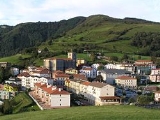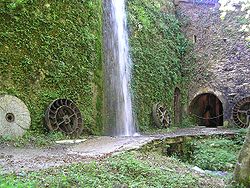
Aia
Encyclopedia
Aia (ˈaɪ.ə, ai.a) is a small village situated on the slopes of Mount Pagoeta in the Basque
province of Gipuzkoa, Spain
. It is located 30 km to the west of Donostia-San Sebastián
and about 10 km inland from the coastal town of Zarautz
. Aia is set amongst rolling green hills and lush green forests, and surrounded by some stunning mountain views. The town still retains its ancient character, with the large Church of San Esteban building as an impressive centrepiece. The population of Aia has gradually declined since the 1950s, to a population of 1750 in 2005.
Farming was originally the main economic activity in the Aia district, with families of the small villages living within closed, self-sufficient economic systems. Land was generally owned by the municipality and rented to the farmers to work. Specialised crafts also began to develop, and in particular Aia became a main centre for the production of iron
. This was largely due to the abundance of natural deposits of iron in the area. Numerous foundries
were established in the area, which had a significant impact on the growth of the local population. It was from these foundries that many family lineages in the Aia district developed. The demise of these old forge
s in Guipúzcoa was brought about by the introduction of blast furnace
s that ran on coal
.
sits just to the west of the town of Aia and preserves not only the natural beauty of the area but also the district's cultural heritage. The park contains numerous ruins of old mills, foundries and farmhouses, and even some ancient burial mounds dating back 5,000 years.
 The Agorregi Forge
The Agorregi Forge
, located within the park, is one of the best preserved examples of a foundry in Gipuzkoa province. The forge which can be seen today was built in 1754 by the Lord of Laurgain Palace over the ruins of an earlier version. Lying at the bottom of a deep valley near Manterola farmhouse, it used the river's hydraulic energy to power its great bellows and turn its waterwheels.
Also situated near Aia and within the Pagoeta Nature Reserve is the Iturraran Botanic Garden. The garden was established in 1986 and includes more than 1000 species of plants, trees and shrubs from all over the world. It also includes some endangered flora of the Basque Country.
Basque Country (autonomous community)
The Basque Country is an autonomous community of northern Spain. It includes the Basque provinces of Álava, Biscay and Gipuzkoa, also called Historical Territories....
province of Gipuzkoa, Spain
Spain
Spain , officially the Kingdom of Spain languages]] under the European Charter for Regional or Minority Languages. In each of these, Spain's official name is as follows:;;;;;;), is a country and member state of the European Union located in southwestern Europe on the Iberian Peninsula...
. It is located 30 km to the west of Donostia-San Sebastián
San Sebastián
Donostia-San Sebastián is a city and municipality located in the north of Spain, in the coast of the Bay of Biscay and 20 km away from the French border. The city is the capital of Gipuzkoa, in the autonomous community of the Basque Country. The municipality’s population is 186,122 , and its...
and about 10 km inland from the coastal town of Zarautz
Zarautz
Zarautz is a coastal town located in the province of Gipuzkoa, in the Basque Country, northern Spain.The town is a popular tourist destination with the population swelling from its usual 22,812 to around 60,000 in summer. The Palace of Narros, located adjacent to Zarautz's 2.8 km long beach,...
. Aia is set amongst rolling green hills and lush green forests, and surrounded by some stunning mountain views. The town still retains its ancient character, with the large Church of San Esteban building as an impressive centrepiece. The population of Aia has gradually declined since the 1950s, to a population of 1750 in 2005.
History
Based on cave paintings and engravings and also stone implements that have been found in the Aia district, it is believed that human habitation of the area dates back to over 10,000 years ago. The town of Aia itself was mentioned in one of the oldest documents of Gipuzkoa dated 1025. The town was also mentioned as being part of the Union of Sayaz in the Decree of the Brotherhood of the Province of Gupuzkoa in 1375.Farming was originally the main economic activity in the Aia district, with families of the small villages living within closed, self-sufficient economic systems. Land was generally owned by the municipality and rented to the farmers to work. Specialised crafts also began to develop, and in particular Aia became a main centre for the production of iron
Iron
Iron is a chemical element with the symbol Fe and atomic number 26. It is a metal in the first transition series. It is the most common element forming the planet Earth as a whole, forming much of Earth's outer and inner core. It is the fourth most common element in the Earth's crust...
. This was largely due to the abundance of natural deposits of iron in the area. Numerous foundries
Foundry
A foundry is a factory that produces metal castings. Metals are cast into shapes by melting them into a liquid, pouring the metal in a mold, and removing the mold material or casting after the metal has solidified as it cools. The most common metals processed are aluminum and cast iron...
were established in the area, which had a significant impact on the growth of the local population. It was from these foundries that many family lineages in the Aia district developed. The demise of these old forge
Forge
A forge is a hearth used for forging. The term "forge" can also refer to the workplace of a smith or a blacksmith, although the term smithy is then more commonly used.The basic smithy contains a forge, also known as a hearth, for heating metals...
s in Guipúzcoa was brought about by the introduction of blast furnace
Blast furnace
A blast furnace is a type of metallurgical furnace used for smelting to produce industrial metals, generally iron.In a blast furnace, fuel and ore and flux are continuously supplied through the top of the furnace, while air is blown into the bottom of the chamber, so that the chemical reactions...
s that ran on coal
Coal
Coal is a combustible black or brownish-black sedimentary rock usually occurring in rock strata in layers or veins called coal beds or coal seams. The harder forms, such as anthracite coal, can be regarded as metamorphic rock because of later exposure to elevated temperature and pressure...
.
Attractions
Aia is known for its natural beauty, still situated amongst Basque farmlands largely unchanged over the past couple of hundred years. It has several impressive attractions that are well known across the province. The 1335 acres (5.4 km²) Pagoeta Nature ReservePagoeta Nature Reserve
Pagoeta Nature Reserve is located near the town of Aia in the Basque Province of Gipuzkoa, Spain....
sits just to the west of the town of Aia and preserves not only the natural beauty of the area but also the district's cultural heritage. The park contains numerous ruins of old mills, foundries and farmhouses, and even some ancient burial mounds dating back 5,000 years.

Agorregi Forge
The Agorregi Forge is located within the Pagoeta Nature Reserve, near the town of Aia, in the Basque Province of Gipuzkoa, Spain. It is one of the best preserved examples of a foundry in Gipuzkoa Province. The forge which can be seen today was built in 1754 by the Lord of Laurgain Palace over the...
, located within the park, is one of the best preserved examples of a foundry in Gipuzkoa province. The forge which can be seen today was built in 1754 by the Lord of Laurgain Palace over the ruins of an earlier version. Lying at the bottom of a deep valley near Manterola farmhouse, it used the river's hydraulic energy to power its great bellows and turn its waterwheels.
Also situated near Aia and within the Pagoeta Nature Reserve is the Iturraran Botanic Garden. The garden was established in 1986 and includes more than 1000 species of plants, trees and shrubs from all over the world. It also includes some endangered flora of the Basque Country.
External links
- Aia official website Information available in SpanishSpanish languageSpanish , also known as Castilian , is a Romance language in the Ibero-Romance group that evolved from several languages and dialects in central-northern Iberia around the 9th century and gradually spread with the expansion of the Kingdom of Castile into central and southern Iberia during the...
and BasqueBasque languageBasque is the ancestral language of the Basque people, who inhabit the Basque Country, a region spanning an area in northeastern Spain and southwestern France. It is spoken by 25.7% of Basques in all territories...
. - 360 degree view of Aia AIA in the Bernardo Estornés Lasa - Auñamendi Encyclopedia (Euskomedia Fundazioa)

